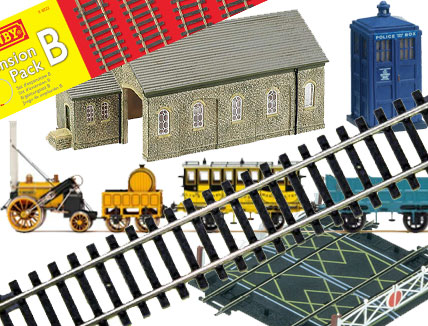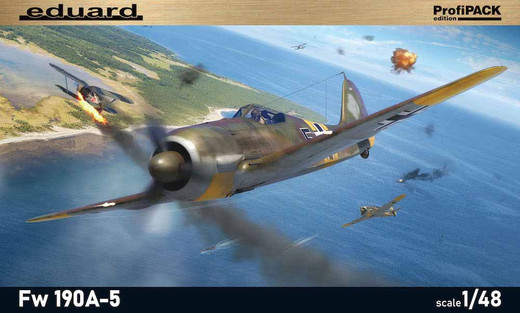Profipack edition kit of German fighter Fw 190A-5 in 1/48 scale.
All machines in the kit are armed with four cannon in the wings.
plastic parts: Eduard
marking options: 6
decals: Eduard
PE parts: yes, pre-painted
painting mask: yes
resin parts: no
Maj. Fritz Losigkeit, CO of I./JG 1, Deelen, the Netherlands, April 1943
Camouflage consists of colors RLM 74, 75 and 76 with spinner in RLM 70. Fritz Losigkeit (1913-1994) was born in Berlin and from October 1936 served in JG "Richthofen". In March 1938 he joined Legion Condor in Spain but was shot down and captured. In April 1939 he joined 2./JG 26 and later became commander of this unit. In June 1941 he started to work in diplomatic mission in Tokyo, Japan. After his return, in March 1942 he took over command of IV./JG 1 (later I./JG 1) in the Netherlands. In June 1943 he took over command of I./JG 26, but during same month he was sent to Eastern Front to lead III./JG 51. In April 1944 he became Kommodore of JG 51 and one year later he took over JG 77. He scored 68 victories in approximately 750 missions and was awarded with Knight´s Cross. His Fw 190 shows flags demonstrating his campaigns and foreign assignments. Devil emblem of IV./JG 1 and victories on rudder are not confirmed by photos. After the war Losigkeit worked for CIA controlled organization Gehlen, later he became secretary of Free Democratic Party (FDP).
Lt. Rüdiger von Kirchmayr, TO ofII./JG 1, Woensdrecht, theNetherlands, spring 1943
Camouflage consists of colors RLM 74, 75 and 76 with spinner in RLM 70. Fritz Losigkeit (1913-1994) was born in Berlin and from October 1936 served in JG "Richthofen". In March 1938 he joined Legion Condor in Spain but was shot down and captured. In April 1939 he joined 2./JG 26 and later became commander of this unit. In June 1941 he started to work in diplomatic mission in Tokyo, Japan. After his return, in March 1942 he took over command of IV./JG 1 (later I./JG 1) in the Netherlands. In June 1943 he took over command of I./JG 26, but during same month he was sent to Eastern Front to lead III./JG 51. In April 1944 he became Kommodore of JG 51 and one year later he took over JG 77. He scored 68 victories in approximately 750 missions and was awarded with Knight´s Cross. His Fw 190 shows flags demonstrating his campaigns and foreign assignments. Devil emblem of IV./JG 1 and victories on rudder are not confirmed by photos. After the war Losigkeit worked for CIA controlled organization Gehlen, later he became secretary of Free Democratic Party (FDP). Camouflage consists of colors RLM 74, 75 and 76 with spinner in RLM 70. Mythical Alpine creature Tatzelwurm is marking of II./JG 1 (former- ly I./JG 3). This Fw 190 was also simultaneously used by JG 300. Rüdiger von Kirchmayr was born in 1921 at Klosterneuberg in Austria. From summer 1941 he scored first five victories with 4./JFS 5 in France. He was transferred to Ergänzung-Jagdgruppe West in February 1942. In early June 1942 von Kirchmayr was assigned to 4./JG 1 in Holland and in April 1943, he was appointed Technische Offizier of Stab II./JG 1. He became Staffelkapitän of 5./JG 1 in 1943 and during this period he claimed or heavily damaged 17 B-17s and B-24s. On August 13th, 1944 he was shot down and wounded by US fighters. Von Kirchmayr was appointed CO of I./JG 11 in October 1944 and from January 1945 fought on the Eastern Front. In April he left JG 11 and became member of Galland´s JV 44 with Me 262s. His score was probably around 50 victories in 392 missions.
Maj. Hans Philipp, CO of JG 1, Deelen, theNetherlands, July 1943
Camouflage consists of colors RLM 74, 75 and 76 with spinner in RLM 70. Fritz Losigkeit (1913-1994) was born in Berlin and from October 1936 served in JG "Richthofen". In March 1938 he joined Legion Condor in Spain but was shot down and captured. In April 1939 he joined 2./JG 26 and later became commander of this unit. In June 1941 he started to work in diplomatic mission in Tokyo, Japan. After his return, in March 1942 he took over command of IV./JG 1 (later I./JG 1) in the Netherlands. In June 1943 he took over command of I./JG 26, but during same month he was sent to Eastern Front to lead III./JG 51. In April 1944 he became Kommodore of JG 51 and one year later he took over JG 77. He scored 68 victories in approximately 750 missions and was awarded with Knight´s Cross. His Fw 190 shows flags demonstrating his campaigns and foreign assignments. Devil emblem of IV./JG 1 and victories on rudder are not confirmed by photos. After the war Losigkeit worked for CIA controlled organization Gehlen, later he became secretary of Free Democratic Party (FDP). Camouflage consists of colors RLM 74, 75 and 76 with spinner in RLM 70. Mythical Alpine creature Tatzelwurm is marking of II./JG 1 (former- ly I./JG 3). This Fw 190 was also simultaneously used by JG 300. Rüdiger von Kirchmayr was born in 1921 at Klosterneuberg in Austria. From summer 1941 he scored first five victories with 4./JFS 5 in France. He was transferred to Ergänzung-Jagdgruppe West in February 1942. In early June 1942 von Kirchmayr was assigned to 4./JG 1 in Holland and in April 1943, he was appointed Technische Offizier of Stab II./JG 1. He became Staffelkapitän of 5./JG 1 in 1943 and during this period he claimed or heavily damaged 17 B-17s and B-24s. On August 13th, 1944 he was shot down and wounded by US fighters. Von Kirchmayr was appointed CO of I./JG 11 in October 1944 and from January 1945 fought on the Eastern Front. In April he left JG 11 and became member of Galland´s JV 44 with Me 262s. His score was probably around 50 victories in 392 missions. Camouflage consists of colors RLM 74, 75 and 76 with spinner in RLM 70 and heavy mottling on fuselage in RLM 74, 75 and 02. It is personal mount of Kommodore Philipp, the "Minke" and "Pinke" refer to names of his dachshunds. In June 1943 this unusual ship was flown also by Adjutant of I./JG 1 Lt. Eberhard Burath (7 v.). Hans "Fips" Philipp (1917) was born in Saxony. In 1938 he started to serve in Stuka unit, but before outbreak of war he was transferred to 1./JG 76 (later 4./JG 54 "Grünherz"). Philipp scored first victory in Poland and added seven more during French campaign. In October 1940 he was awarded with Knight´s Cross after 20 victories. During attack against Yugoslavia he claimed two Bf 109s shot down. In war against Soviet Union he scored 178 victories and from February 1942 he led I./JG 54. In April 1943 he was appointed as CO of JG 1 in the Netherlands. On October 8th, 1943 he was killed in combat with B-17s and US fighters. Philipp was awarded with Knight´s Cross with Oak Leaves and Swords. He scored 206 victories in over 500 missions.
WNr. 1230, Obstlt. Walter Oesau, CO of JG 2, Beaumont le Roger, France, June 1943
Aircraft was manufactured by Focke-Wulf in Marienburgu in first half of 1943. Camouflage consists of colors RLM 74, 75 and 76 with spinner in RLM 70. Rudder shows five Oesau´s victories (Nr. 101 - 105) against four-engined bombers. Walter “Gulle” Oesau (1913) joined JG “Richthofen” before the war and in April 1938 was transferred to Legion Condor in Spain. In August 1940 as CO of 7./JG 51 he was awarded with Knight´s Cross after gaining 20 victories in WWII. He briefly led III./JG 51 and in November was appointed CO of III./JG 3. On July 15th, 1941 his victory tally had reached 80 and he was awarded with Swords. At the end of July 1941 he took command of JG 2 in France. Oesau recorded his 100th victory on October 26th, 1941. In November 1943 Oberst Oesau was appointed Kommodore of JG 1 following the death of Oberst Hans Philipp. On May 11th, 1944, Oesau was killed by P-38s in Bf 109G-6/AS (W.Nr. 20 601) “Green 13” near St Vith. “Gulle” Oesau scored 127 victories in over 300 combat missions. 9 in Spain, 74 in the West and 44 over the Eastern front.
WNr. 1197, Oblt. Otto Stammberger, CO of 4./JG 26, Abbéville-Drucat, France, May 1943
Aircraft was manufactured by Focke-Wulf in Marienburgu in first half of 1943. Camouflage consists of colors RLM 74, 75 and 76 with spinner in RLM 70. Otto “Stotto” Stammberger (1920 - 2001) joined the Luftwaffe on September 1st, 1939, and in February 1941 was assigned to 9./JG 26. He scored first victory, a Spitfire over Dieppe, on August 19th, 1942. In February 1943, Stammberger was appointed Staffelkapitän of 4./JG 26. On May 13th, he was shot down and wounded by Spitfires of No.331 Squadron near St Omer. Stammberger returned to JG 26 in October but was not permitted to fly in combat. He was transferred to 2./JGr West based at Biaritz in France. On December 31st, 1943, he claimed a B-17 near Bergerac. This was Stammberger’s seventh, and last, victory. On January 24th, 1944, he was injured during take--off accident. He spent the remainder of the war serving in staff roles with JG 26. Post war, Stammberger became the manager of a large department store.
Oblt. Maximilian Stotz, CO of 5./JG 54, Siverskaya, Soviet Union, May 1943
Aircraft is probably WNr. 5888 manufactured by Arado in Warnemünde at beginning of 1943. Camouflage consists of brown and green colors on upper surfaces, RLM 76 on undersides with spinner in RLM 70. Stotz was born in Austria in 1912 and in 1933 entered Austrian Army. From 1938 he belonged to Austrian aerobatic team. In Luftwaffe, Stotz was assigned to 1./JG 76 (later 4./JG 54 "Grünherz") and scored first victory in November 1939. He scored 12 victories during French campaign but suffered injury during Battle of Britain. After Balkan campaign he fought on Eastern Front and in June 1942 received Knight´s Cross after 53 victories. Oak Leaves followed soon after he scored his 100th victory in October. From April 1943 he led 5./JG 54 but was missing "Black 7" after brief head-on encounter with enemy fighters on August 19th, 1943. His original "Black 5" was probably flown by his wingman Uffz. Herbert Koller (50 v.) who made belly landing. "Black 5" (WNr. 5888) was finally lost on October 7th, 1943 with Lt. Karl-Heinz Lüchau (12 v.) wounded. Final score of Stotz was 182 victories. He was promoted to Hauptmann posthumously.
 Loading... Please wait...
Loading... Please wait...










































